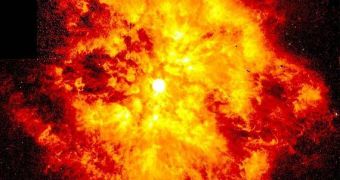Astronomers have finally discovered proof that confirms a long-held belief, namely that the shock waves generated by supernova explosions act like giant and extremely powerful particle accelerators. They came to this conclusion when they recently discovered that cosmic-ray particles, generated only when a massive star collapses onto itself and explodes into a supernova, carried an enormous amount of energy, at speeds nearing that of light. The study appears in the June 26th issue of the journal Science.
These cosmic rays are mostly made up of highly energetic protons, which travel the Universe at a speed of about 30 million kilometers per hour. But, as they get further away from their source of origin, the supernova, the shock waves they create start interacting with the Inter-Stellar Medium (ISM). This ISM has its own magnetic field, which is fairly strong, and able to trap the high-speed protons, bouncing them back to the supernova. But the remnant has its own magnetic field, which bounces the protons back to the ISM, as in a game of table tennis.
The thing is that each of the bounces adds even more energy and speed to the protons, until, finally, they escape their traps, and, accelerated to nearly the speed of light, start making their way through deep space. Eventually, some of them reach the Earth, and astronauts on the International Space Station have reported that these particles are so energetic, that they sometimes see flashes of light, when a single proton smashes into their retinas. They said that this happened regardless of whether they kept their eyes opened or closed, ScienceNow reports.
In a new experiment, which made use of the Very Large Telescope (VLT) in Paranal, Chile, and the NASA Chandra X-ray Observatory, an international astronomical cooperation analyzed a supernova remnant some 8,200 light-years away, in the constellation Circinus. Over several years of measurements, the team was finally able to establish the speed of protons traveling in front and behind the shock waves generated by the original explosion.
“We did not expect such a high shock velocity,” Utrecht University Astronomer Eveline Helder, who is also the lead author of the Science paper, said. The researchers added that the force of the protons surpassed even the team's maximum calculations. An important find that the scientists made was the fact that most of the energy the shock wave had was used to accelerate the protons, as if in a massive particle accelerator, rather than for generating heat.
“It confirms predictions that shocks can be extremely efficient proton accelerators,” North Carolina State University Physicist Donald Ellison explained. He also added that the new research could ultimately be used to better understand some of the most bizarre phenomena in deep space, such as gamma-ray bursts and quasars' emissions, which are little understood at this point.

 14 DAY TRIAL //
14 DAY TRIAL //